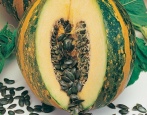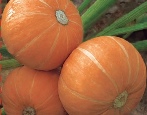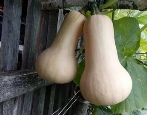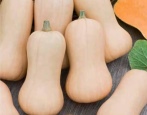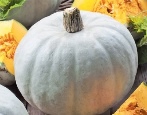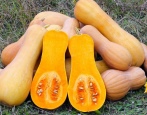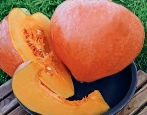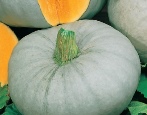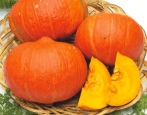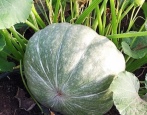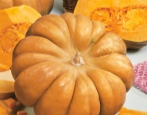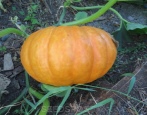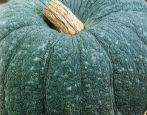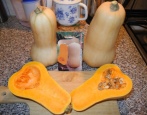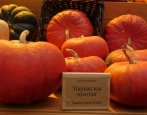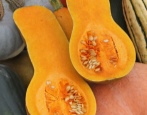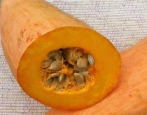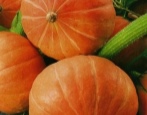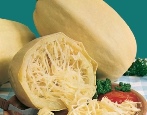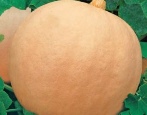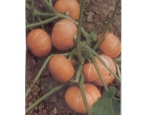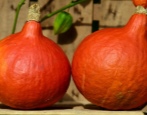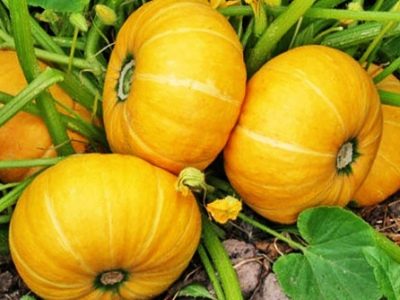
- Year of approval: 1995
- Growth type: compact
- Leaf shape: pentagonal
- Leaf color: green, no mottling
- The form: spherical, short-oval and oval
- Weight, kg: 4,7
- Coloration: background color orange, no pattern
- Bark: thin, leathery
- Color of the pulp: yellow
- Pulp thickness, cm: until 6
Thanks to the work of breeders, you can grow a tasty and healthy pumpkin even in a small garden bed. The main thing is to choose a variety with compact vegetation, for example, a bush type. These include the early-ripening orange bush pumpkin of Russian selection.
Breeding history
Orange bush pumpkin is a popular variety, which was bred by scientists of the Kuban experimental station in 1989. Having passed numerous variety trials, in 1995 the vegetable crop entered the State Register of Breeding Achievements of the Russian Federation. It is recommended to grow a vegetable in the Central, West Siberian, Volgo-Vyatka and North-West regions.
Description of the variety
This variety is a compact bush type plant. The vegetable culture is characterized by shortened whips, medium thickening with light green pentagonal leaves with noticeable dissections, a fragile root system, as well as developed stems with pronounced pubescence. During the flowering period, the bush is covered with large bright yellow flowers. On average, 2-3 leveled specimens are formed and matured on each bush.
Characteristics of the appearance of plants and fruits
Shrub orange is a representative of medium-sized varieties. Vegetables ripen neat and leveled. The average weight of a pumpkin is 4.7-5 kg, sometimes the vegetables grow larger, reaching 7 kg. The shape of the vegetable is spherical or oval, with a smooth surface and a slight sheen. The expressed surface relief of the vegetable is not observed. The bark of the pumpkin is very thin and fragile. The color of the peel is dark orange, without patterns. The seed nest of the vegetable is small. There are not very many seeds in the pumpkin pulp - they are medium-sized and flat.
Cut vegetables, despite the brittleness of the bark, easily tolerate transportation, and are also endowed with the ability to be stored for a long time without loss of taste and marketability.
Purpose and taste
Pumpkin is famous for its good taste. Pumpkin pulp has a fleshy, tender, moderately dense and juicy structure. The fruit has a harmonious taste - pronounced sweetness goes well with a bright aroma and a light honey aftertaste. The thickness of the pulp is 5-6 cm. The pulp of the vegetable is saturated with useful vitamins and microelements.
In addition, pumpkin belongs to low-calorie varieties, therefore it is included in the dietary and children's menu. In cooking, the vegetable is also widely used - they prepare soups, desserts, salads, casseroles, preserves, and are used as filling for pies. Experienced culinary experts use this pumpkin variety during the preparation of marinades, sauces, and canning.
Ripening terms
The variety is early maturing. From the appearance of the first shoots to mature specimens on the ridge, it takes from 92 to 104 days. The dry stalk and uniform cover of the pumpkin bark indicate the absolute ripeness of vegetables. You can cut the fruits from July to September.
Yield
Orange bush pumpkin is a highly productive variety. It is characteristic that weather disasters do not affect the yield of vegetable crops. On average, 12-15 kg of juicy fruits can be obtained from 1 m2 of plantings, and growing a vegetable on an industrial scale, from 1 hectare of plantings, from 19 to 54 tons of pumpkin are harvested.
Growing and care
The variety can be cultivated both by the seed method and by the seedling method. Direct sowing of seeds is allowed only in the southern regions. Seeds are pre-sorted and disinfected. The seeds are immersed in the soil to a depth of 5-6 cm. Sowing is carried out according to the scheme 60x60 cm. The work should be carried out in late May - early June, when the temperature regime has stabilized. To speed up the emergence of sprouts, you can cover the plantings with foil.
Sowing for seedlings is carried out in March, and mature bushes with 3-5 leaves are transplanted into the ground at the end of May, in early June.
The agricultural technology of the culture is simple, it is enough to water the bushes every week with settled water, loosen the soil (3 times a month), weed the aisles, apply fertilizers twice a season, alternating organic matter and mineral complexes, and prevent fungal infections. In addition, if the vegetables are too large to ripen, then a support will be required.
Legumes, greens, and cabbage are good precursors for pumpkin.
Requirements for soil and climatic conditions
Vegetable culture Shrub orange is a stress-resistant variety, therefore it is able to withstand temperature extremes, cold snaps and short droughts. Despite this, it is recommended to grow the vegetable in sunny areas, where there is abundant sun, light and warmth. Experienced vegetable growers prefer to plant pumpkin in low elevations with a draft barrier. It is most comfortable for pumpkins to grow in light, loose, fertile loamy and sandy loam substrates. It is important that the soil is not acidic and heavy.
Disease and pest resistance
The immunity of the variety is average, so you should strictly follow the rules of crop rotation, agricultural technology, and also do not forget about the prevention of viruses. Dangerous diseases for a vegetable are: bacteriosis, powdery mildew and white rot. Landings are attacked by slugs and spider mites.
